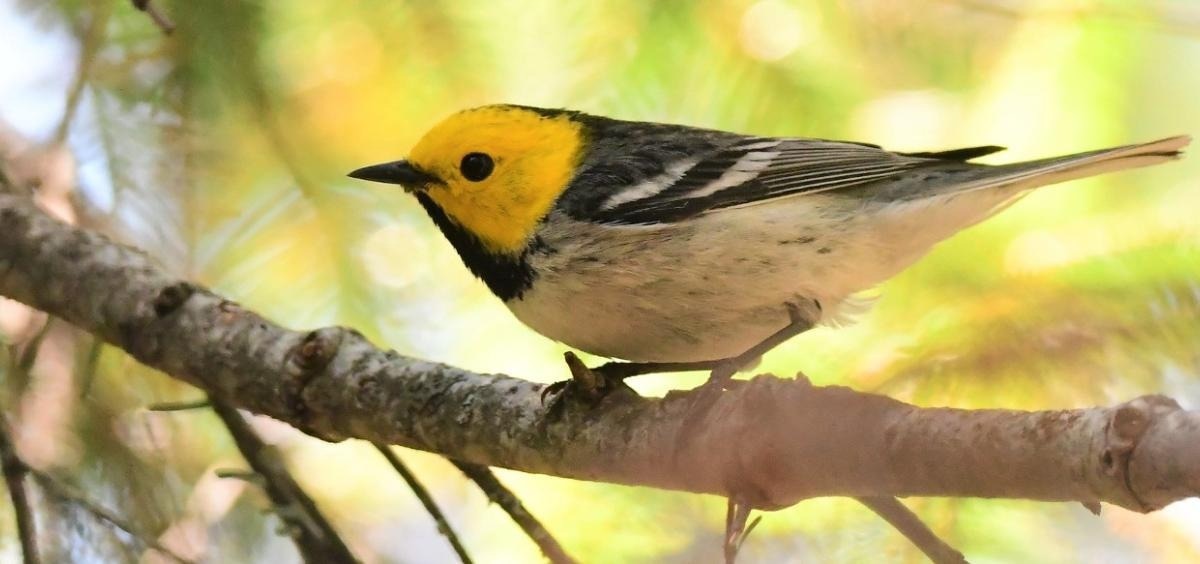According to research from the Oregon State University College of Forestry, some bird species may be protected from climate change by old-growth forests and managed forests with old-growth traits.
 Hermit warbler. Image Credit: Hankyu Kim
Hermit warbler. Image Credit: Hankyu Kim
Hankyu Kim, a former doctoral candidate at Oregon State University, based on earlier research led by Matt Betts, a professor in the Department of Forest Ecosystems and Society, demonstrated how some bird species that are threatened by climate change can find refuge in old forests with large trees and a variety of tree species and sizes.
According to the scientists, the most recent findings have significant implications for conservation choices involving mature forests and are even more pertinent in light of the new Inflation Reduction Act, which calls for increased funding to map and safeguard the United States remaining old-growth forests.
The study, which was released today in Global Change Biology, examined “microclimates” in forests. Microclimates are unique local climatic conditions in places as small as a few square meters up to many square kilometers.
Coastal regions, islands, and mountains like Oregon’s Cascade Range, home to the HJ Andrews Experimental Forest where Kim and Betts conducted their research, tend to have the most noticeable microclimates.
In addition to subcanopy temperature measurements, ground- and LiDAR-based vegetation data, and eight years worth of breeding bird abundance data from an HJ Andrews watershed, the OSU researchers also worked with collaborators from Oregon State and the United States Forest Service. They concluded that some bird species tended to perform better in places with colder microclimates, which they refer to as the “buffering effect.”
The “insurance effect,” which refers to the fact that compositional diversity helps ensure the existence of the insects the birds eat when they most need nutrition and energy—during breeding season—meant that some species also did better in areas where the forest had higher compositional diversity.
To my knowledge, this is the first empirical evidence of any microclimate effect on songbird populations, and of the insurance effect on free-ranging birds. Each species may have a slightly different range of thermal optima—the range of thermal conditions they feel comfortable with—and it could be the same for the interaction between forest ecosystems and birds.
Hankyu Kim, Postdoctoral Researcher, University of Wisconsin-Madison
He explained that some birds interact with the forest ecology under the current warming regime to their advantage, while others find it challenging to reproduce there since the food supply has altered negatively.
The researchers discovered that in colder microclimates, abundance trends for five of the 20 bird species they studied tended to be either neutral or less negative and that the adverse effects of warming on two species were lessened in areas with greater forest compositional diversity.
The Swainson’s thrush, chestnut-backed chickadee, hermit warbler, variegated thrush, and Wilson’s warbler were the five species that benefited from the buffering effect. The only two species with statistical proof that benefited from the insurance effect were Wilson’s warbler and the red crossbill.
If plants leaf out earlier in warm microclimates, causing arthropods to emerge earlier, there is a danger of migratory birds mistiming their breeding with peak food availability. Since leaf-out timing varies by plant species, forests with more plant diversity often have a longer period of insect availability.
Matt Betts, Professor, Department of Forest Ecosystems and Society, Oregon State University
The other 14 birds included in the analysis were the hairy woodpecker, dark-eyed junco, hermit thrush, brown creeper, black-throated gray warbler, golden-crowned kinglet, Hammond's flycatcher, Pacific wren, red-breasted nuthatch, red-breasted sapsucker, western tanager, and yellow-rumped warbler.
Over the eight-year research, 2011–18, seven of the 20 species showed general reductions in abundance. Nine increased, and four did exhibit a discernible trend.
Trends of abundance of five species declined at greater rates in warmer locations than in cooler areas. That suggests microclimates within forested landscapes do provide refugia for those species. Declining species that are sensitive to warm conditions, like the Wilson’s warbler, hermit warbler and chestnut-backed chickadee, seemed to benefit the most from refugia effects.
Hankyu Kim, Postdoctoral Researcher, University of Wisconsin-Madison
Betts thought it was interesting that the same species was declining in the study led by Kim and that the same species benefited from forests with old-growth characteristics. Betts claimed that Kim’s results were “collected independently and more rigorously” than those in the research he led in 2017.
Betts states, “The earlier paper was less well done because we didn’t measure microclimate directly. Our hypothesis was that microclimate buffering should work for a high proportion of the declining species. This current paper is the first time that’s been shown.”
Brenda McComb and Sarah Frey of the OSU College of Forestry and David Bell of the Forest Service’s Pacific Northwest Research Station participated in the study, which the National Science Foundation supported.
Journal Reference:
Kim, H., et al. (2022) Forest microclimate and composition mediate long-term trends of breeding bird populations. Global Change Biology. doi.org/10.1111/gcb.16353.